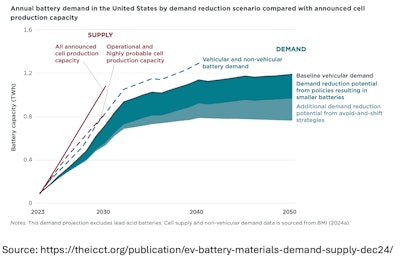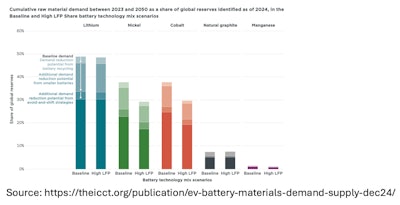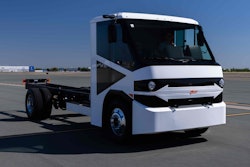Supply and demand of critical materials to facilitate the transition to cleaner transportation is complicated. Are we prepared?
NACFE has done a lot of work on battery electric vehicles (BEVs). By working with the fleets, OEMs, and Tier I suppliers we have helped demonstrate that BEVs have arrived in the trucking industry. We also have studied and highlighted fleets that have started the journey of building on-site charging, as illustrated in our Run on Less Electric Depot report.
As we think about the BEV transition, we also need to think about the supply chain for batteries, motors, and power electronics. NACFE summarized this in our Medium Duty Electric Truck report. Most of us have heard concerns about the availability of precious materials such as cobalt, which is used in many batteries. There are many other materials in batteries, motors, and power electronics that require a resilient supply chain.
One way to think about the supply chain for batteries is to evaluate the availability of raw material reserves, processed material, and battery cell and module production. A recent ICCT study looked at these three elements, and reported some very interesting findings and observations.
The report is impressive in that it is very comprehensive. It looks at global and regional aspects of demand for BEVs, material reserves, and capacity that is either in place or is planned. It also looks at different scenarios that could reduce the demand for raw materials because of recycling or “right-sizing” batteries. The idea of “right sizing” is that, in some cases, vehicles might have too much on-board battery capacity, and the battery size can be reduced.
In summary, “on paper” there are adequate material reserves and capacity to meet the needs for BEVs in the near term. Projections have been made from now until 2050, and there appears to be enough global capacity of raw material, processed material, recycled material and battery cell capacity. China certainly has the lead on all material production and will likely be an exporter to the world.
Here are some key takeaways from the report as well as some comments as to how the trucking industry should respond to the challenges ahead.
Battery cell and module capacity
The figure below illustrates anticipated battery cell production capacity in the United States vs demand. The study quantifies announced capacity as well as “operational” capacity, which is defined as battery manufacturing that is either in operation or under construction. The graph also illustrates anticipated demand and some reduced estimates of demand assuming recycling and “right-sizing.”All is good here!

Mining and processed material capacity
The critical materials that were studied are: lithium, nickel, manganese, graphite, and cobalt. In the latter case, cobalt is often discussed as a concern. Fortunately, there are different battery chemistries such as lithium iron phosphate (LFP) that do not require cobalt.The study uses the phrase that battery material supply “is projected to catch-up” with growing demand. It estimates having near adequate capacity in the 2030 timeframe. There are few noteworthy points, however.
First, no region by itself has an adequate supply of material. This reminds us of how dependent we are on each other. The battery industry and — at a higher level — countries, will need to collaborate and have friendly trade agreements.
The second point is that material capacity in the 2030 timeframe has a lot less margin of capacity than the battery cell production capacity discussed above. In some cases, the anticipated capacity meets the demand within a percent or two. As we think about these projections and the margin of error associated with them, we could be ok, or we could be supply-constrained. As we learned so painfully during the pandemic, supply-constrained is a not a pleasant thing and results in inflation and other problems.
Finally, huge investments are needed. For a given mine and the processing of material, it can take 10 to 20 years and billions of dollars of investment. We need stable and consistent policies so that companies and countries can make the needed investments. Also, we need to make sure that environmental and trade policies are established and consistent throughout the world. More specifically, there are practices in some regions where some of these processes are not environmentally friendly, workers are exposed to toxic material, and child labor laws are violated
Raw material reserves
Material reserves appear to be adequate. The figure below illustrates the available raw material demand between 2023 and 2050 as a share of the global reserves. The graph indicates that there should be adequate material, however, there a couple of noteworthy points.It is a snapshot of today’s global reserves. History has shown that future exploration is likely, and the reserves will grow over time. Demand may grow beyond expectations if parallel industries require these materials for stationary energy storage, power generation, power distribution, AI computer centers, commercial electronics, aircraft, ships, etc. The future supply and demand of strategic materials is difficult to accurately predict.
As noted above, it take a lot of time to explore new material, establish a mine, and process the material.

I opened this blog by saying “on paper,” we have adequate resources. One of my greatest mentors (we called them bosses back in the day), used to ask us if our designs “worked on paper.” He would then say that if it works on paper, it has a 50% chance of working in the real world. This was a great lesson for me that taught me to do my homework and make sure the proper requirements and analysis were done, but then to make sure the remaining 50% was done so that we could be successful.
In this case, I think the remaining 50% is that we need to make sure that we have stable and long-standing policy so that proper investments can be made, to make sure that environmental concerns are addressed, and that we have good cooperation and trade agreements globally. These will be major undertakings for countries and the trucking industry for us to be successful in this journey to decarbonization.














